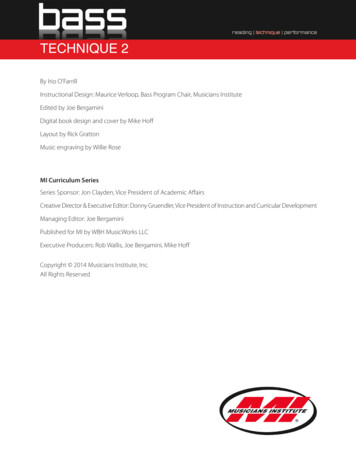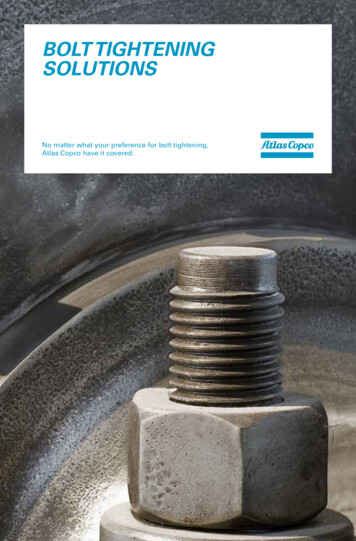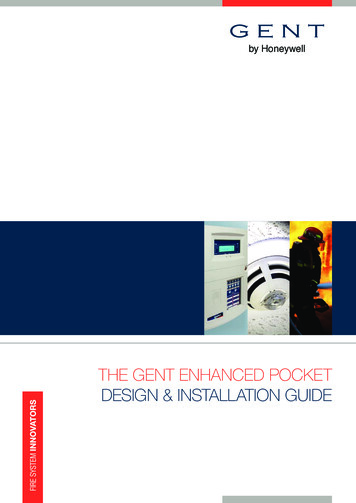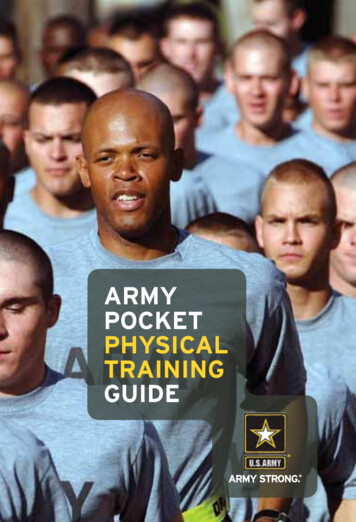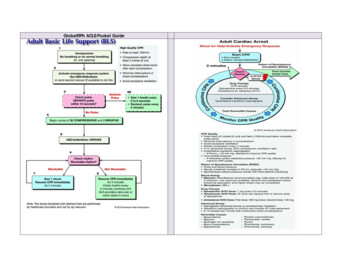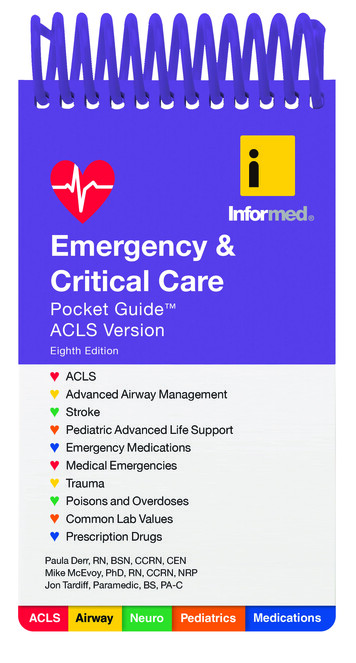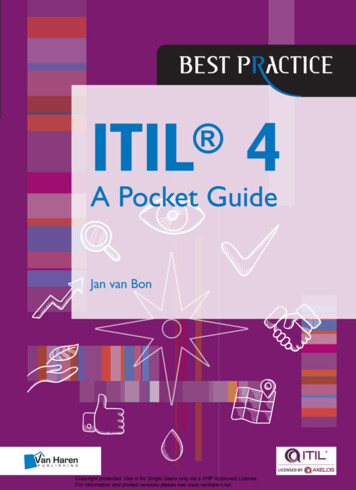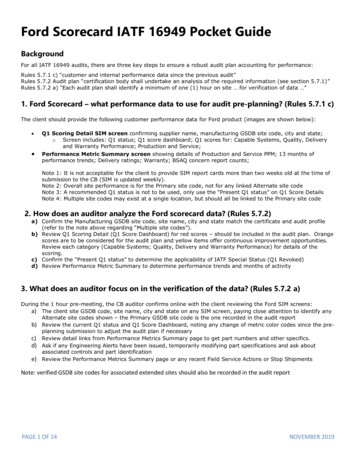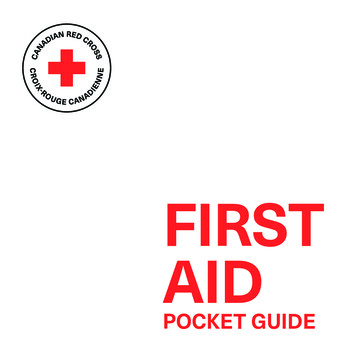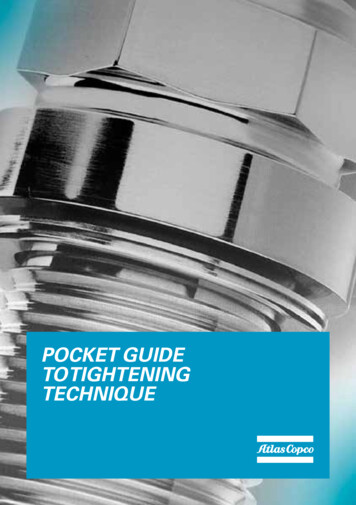
Transcription
POCKET GUIDETO TIGHTENINGTECHNIQUE
2POCKET GUIDE TO TIGHTENING TECHNIQUE
POCKET GUIDE TO TIGHTENING TECHNIQUEChapter.Page1. Why threaded fasteners?.42. The screw joint.43. Clamping force.64. Effect of lubrication.75. Screw quality classification.86. Joint types. 107. Torque and angle. 118. Measurement methods.129. The tightening process.1410. Mean shift.1511. Standards for measurement.1612. Certification.1613. Errors in tightening.1714. Damaged threads.1715. Missing joint components.1716. Relaxation .1717. Prevailing torque.1818. Tightening tools.18Summary.25POCKET GUIDE TO TIGHTENING TECHNIQUE3
POCKET GUIDE TO TIGHTENING TECHNIQUEThis booklet provides an introduction to the technique of using threaded fasteners for assembling components, the application of power tools for the assembly and the influence oftool selection on the quality of the joint.1. WHY THREADED FASTENERS?There are several ways of securing parts and components toeach other, e.g. gluing, riveting, welding and soldering.However, by far the most common method of joining components is to use a screw to clamp the joint members with anut or directly to a threaded hole in one of the components.The advantages of this method are the simplicity of designand assembly, easy disassembly, productivity and in the end– cost.2. THE SCREW JOINTA screw is exposed to tensile load, to torsion and sometimesalso to a shear load.The stress in the screw when the screw has been tightened tothe design extent is known as the pre-stress.The tensile load corresponds to the force that clamps the jointmembers together. External loads which are less than theclamping force will not change the tensile load in the screw.On the other hand, if the joint is exposed to higher externalloads than the pre-stress in the bolt the joint will come apartand the tensile load in the screw will naturally increase untilthe screw breaks.4POCKET GUIDE TO TIGHTENING TECHNIQUE
Tensile loadClamping forceShear loadShear loadShear load and tensile load.Tensile loadTorsion in the screw results from friction between the threadsin the screw and the nut.Some screws are also exposed to shear loads which occurwhen the external force slides the members of the joint inrelation to each other perpendicular to the clamping force. Ina properly designed joint the external shear force should beresisted by the friction between the components. A joint ofthis kind is called a friction joint. If the clamping force is notsufficient to create the friction needed, the screw will also beexposed to the shear load. Joints are frequently designed fora combination of tensile and shear loads.The screw is made up of the shank and the head. The shank isthreaded, either for part of its length or for the full length fromthe end to the head. Longer screws are usually only partlythreaded. There is no need to make a thread longer than isnecessary to tighten the joint as this will only make the screwmore expensive and reduce the tensile strength.The dimensions of threads, the shape of the thread and thepitch, i.e. the distance between successive threads, have beenstandardized. In practice there are only two different standards used today in industry; the Unified standard UN, originally used in the Anglo-Saxon countries, and the EuropeanMetric standard M.Basic screw design.POCKET GUIDE TO TIGHTENING TECHNIQUE5
Apart from the basic dimensional differences the UN and Mstandards have different angles and depths of thread. Bothstandards include separate specifications for fine t hreads. TheUN fine thread standard UNF is quite common parallel to thenormal UNC type.Pitch mm/rotation3. CLAMPING FORCEIn general it is desirable that the screw is the weakest memberof the joint. An over-dimensioned screw makes the productboth heavier and unnecessarily expensive. As a standard screwis usually comparatively inexpensive it is preferable that thescrew should be the first part to break.Furthermore, in most cases the dimensions of the screw arenot critical for the quality of the joint. What is decisive is theclamping force, i.e. whether it is sufficient to carry all the loadfor which the joint is designed, and whether the joint will remain tight enough to prevent loosening if exposed to pulseloads.The problem is that there is no practical way to measure theclamping force in normal production situations. Consequentlythe value of the clamping force is usually referred to as thetightening torque.As the clamping force is a linear function of both the turningangle of the screw and the pitch of the thread, there is a directrelation between the clamping force and the tightening torquewithin the elastic range of the screw elongation. However, onlyabout 10% of the torque applied is transferred into clampingforce. The remaining tightening force is consumed in friction inthe screw joint – 40% of the torque to overcome the friction inthe thread and 50% in friction under the screw head.6POCKET GUIDE TO TIGHTENING TECHNIQUE
4. EFFECT OF LUBRICATIONIf a screw is lubricated, the friction in the threads and underthe head is decreased and the relation between tighteningtorque and clamping force is changed. If the same torque isapplied as before lubrication, a lot more torque will be transformed into clamping force. At worst this might lead to thetension in the screw exceeding the tensile strength and breaking of the screw.On the other hand, if the screw is completely dry of lubricantthe clamping force might be too small to withstand the forcesfor which the joint is designed, with the risk that the screwbecomes loose.DryLightly oiledUntreatedBolt materialUntreatedNut material0.18-0.350.14-0.26Phosphorous coatedUntreated0.25-0.400.17-0.30Electro Zinc platedUntreated0.11-0.360.11-0.20Phosphorous coatedPhosphorous coated0.13-0.240.11-0.17Electro Zinc platedElectro Zinc plated0.18-0.420.13-0.22Table 1. Friction in threads ofdifferent material.POCKET GUIDE TO TIGHTENING TECHNIQUE7
5. SCREW QUALITY CLASSIFICATIONWhen a screw is tightened and the clamping force starts tobuild up, the material of the screw is stressed. After a shorttime when the thread settles the material will stretch in proportion to the force. In principle, this elongation will continueuntil the stress in the screw is equal to the tensile strengthat which the screw will break. However, as long as the elongation is proportional to the stress the screw will regain itsoriginal length when the load is removed. This is known asthe elastic area.StressYield pointFailureAngular displacementAt a certain stress, known as the yield point, plastic deformation of the material in the screw will occur. However, thescrew will not break immediately. Torque will continue toincrease but at a lower torque rate during the deformationabove the yield point. The plastic deformation will result in apermanent elongation of the screw if the joint is loosened.For very accurate clamping force requirements this area issometimes deliberately specified for the tightening process.Beyond the plastic area breakage occurs.8POCKET GUIDE TO TIGHTENING TECHNIQUE
M-Threaded screwboltsTightening torque Nm, according to ISO 898/1The material qualities of screws are standardized, i.e. theamount of tensile stress they can be exposed to before theyield point is reached and before breakage occurs. All screwsshould be marked according to their Bolt Grade – a classification standard in a two-digit system where the first digit refersto the minimum tensile strength in 100 N/mm2 and the seconddigit indicates the relation between the yield point and theminimum tensile strength. For example: Bolt Grade 8.8 designates a screw with 800 N/mm2 minimum tensile strength anda yield point of 0.8 x 800 640 N/mm2.Table 2. Table for different classes of screws.Bolt 0545076609190POCKET GUIDE TO TIGHTENING TECHNIQUE9
Example of screw d esignation.6. JOINT TYPESScrew joints vary not only in size but also in type, whichchanges the characteristics of the joints. From a tightening point of view the most important quality of a joint is the“hardness”. In figures this can be defined as the “torque rate”,which is the tightening angle necessary to achieve the recommended torque of the screw dimension and quality in question measured from the snug level – the point at which thecomponents and the screw head become tight.The torque rate can vary considerably for the same diameterof screw. A short screw clamping plain metal componentsreaches the rated torque in only a fraction of a turn of thescrew. This type of joint is defined as a “hard joint”. A jointwith a long screw that has to compress soft components suchas gaskets or spring washers requires a much wider angle,possibly even several turns of the screw or nut to reach therated torque. This type of joint is described as a soft joint.Obviously the two different types of joints behave differentlywhen it comes to the tightening process.10POCKET GUIDE TO TIGHTENING TECHNIQUE
7. TORQUE AND ANGLEAs mentioned above, the tightening torque is for practical reasons the criteria normally used to specify the pre-stressin the screw. The torque, or the moment of force, can bemeasured either dynamically, when the screw is tightened, orstatically, by checking the torque with a torque wrench aftertightening.Ta2rFTbrTorque specifications vary considerably depending on thequality demands of the joint. A safety critical joint in a motor car, such as the wheel suspension, cannot be allowed tofail and is consequently subject to very stringent tolerancerequirements. On the other hand a nut for securing the lengthof a workbench height adjustment screw is not regarded ascritical from a clamping force point of view and no torque requirement may be specified.A higher level of quality control is reached by adding thetightening angle to the measured parameters. In the elasticarea of the screw this can be used to verify that all the members of a joint are present, e.g. that a gasket or a washer is notmissing. Also, the screw quality can be verified by measuringthe tightening angle, prior to snug level as well as for finaltorque-up.30 In sophisticated tightening processes the anglecan also be used to define the yield point andallow tightening into the plastic area of the screw.60 POCKET GUIDE TO TIGHTENING TECHNIQUE11
8. MEASUREMENT METHODSKnowing the tightening specifications for a screw joint theobvious question is; how does one know that the joint hasbeen properly tightened?Torque measurements are made according to one of two principles – static measurement or dynamic measurement.Static measurement means that the tightening torque ischecked after the tightening process has been completed. Themeasurement is usually done by hand with a torque wrenchwhich has either a spring loaded torque scale or a straingauge transducer activated instrument.A very common method for checking the tightening torqueis to use a click wrench, which is a torque wrench equippedwith a clutch that can be pre-adjusted to a specific torque. Ifthe torque is greater than the preset torque value the clutchwill release with a click. If the torque is less, final torque-upis possible until the wrench clicks. Over-tightening cannot bedetected with the click wrench.To measure the static torque the torque value must be readinstantly as the screw starts to turn.An electronic torque wrench can be used for a more sophisticated static measurement of the joint. The tool has straingauge torque transducer which gives a high level of accuracy.Electronic torque wrench (staticmeasurement).12Dynamic measurement on the other hand means that thetorque is continuously measured during the complete tighten ing cycle. This is usually the preferred method in productionwhere power tools are used for tightening. The advantageover the static method is that dynamic measurement providesan indication of the tightening tool performance without theinfluence of relaxation in the joint and variations in re
4 POCKET GUIDE TO TIGHTENING TECHNIQUE This booklet provides an introduction to the technique of us-ing threaded fasteners for assembling components, the ap-
